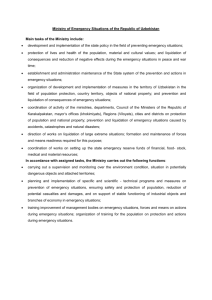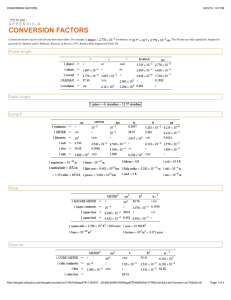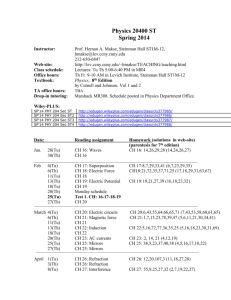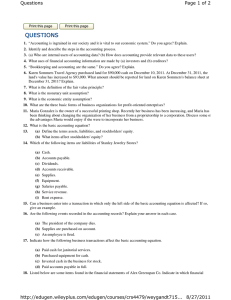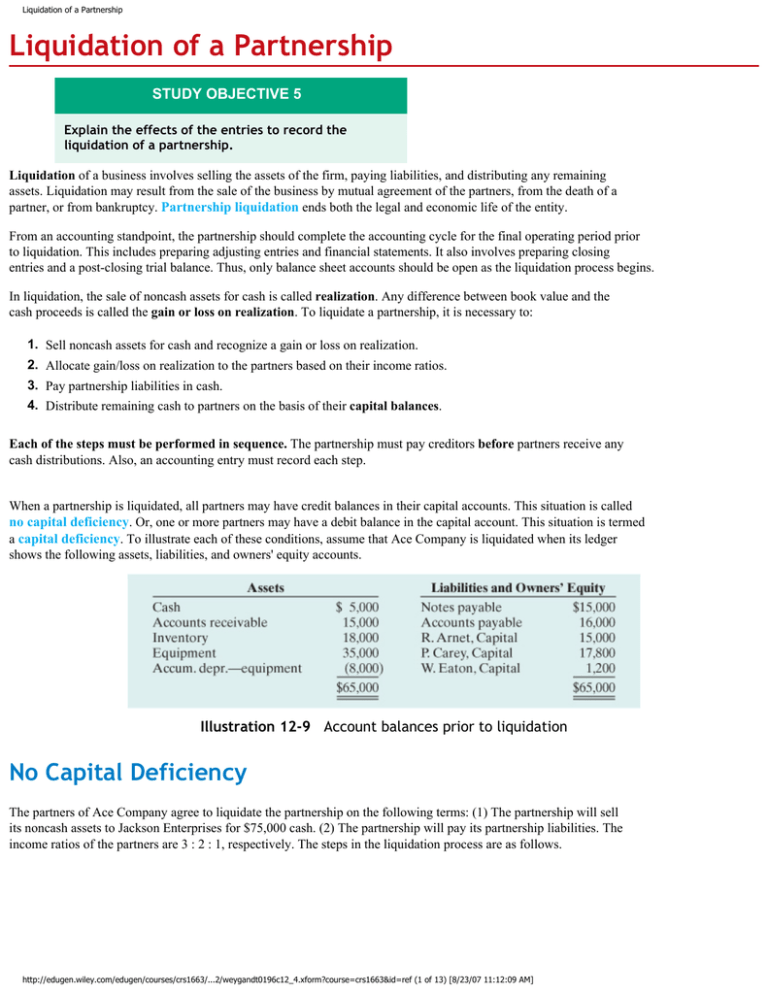
Liquidation of a Partnership
Liquidation of a Partnership
STUDY OBJECTIVE 5
Explain the effects of the entries to record the
liquidation of a partnership.
Liquidation of a business involves selling the assets of the firm, paying liabilities, and distributing any remaining
assets. Liquidation may result from the sale of the business by mutual agreement of the partners, from the death of a
partner, or from bankruptcy. Partnership liquidation ends both the legal and economic life of the entity.
From an accounting standpoint, the partnership should complete the accounting cycle for the final operating period prior
to liquidation. This includes preparing adjusting entries and financial statements. It also involves preparing closing
entries and a post-closing trial balance. Thus, only balance sheet accounts should be open as the liquidation process begins.
In liquidation, the sale of noncash assets for cash is called realization. Any difference between book value and the
cash proceeds is called the gain or loss on realization. To liquidate a partnership, it is necessary to:
1. Sell noncash assets for cash and recognize a gain or loss on realization.
2. Allocate gain/loss on realization to the partners based on their income ratios.
3. Pay partnership liabilities in cash.
4. Distribute remaining cash to partners on the basis of their capital balances.
Each of the steps must be performed in sequence. The partnership must pay creditors before partners receive any
cash distributions. Also, an accounting entry must record each step.
When a partnership is liquidated, all partners may have credit balances in their capital accounts. This situation is called
no capital deficiency. Or, one or more partners may have a debit balance in the capital account. This situation is termed
a capital deficiency. To illustrate each of these conditions, assume that Ace Company is liquidated when its ledger
shows the following assets, liabilities, and owners' equity accounts.
Illustration 12-9 Account balances prior to liquidation
No Capital Deficiency
The partners of Ace Company agree to liquidate the partnership on the following terms: (1) The partnership will sell
its noncash assets to Jackson Enterprises for $75,000 cash. (2) The partnership will pay its partnership liabilities. The
income ratios of the partners are 3 : 2 : 1, respectively. The steps in the liquidation process are as follows.
http://edugen.wiley.com/edugen/courses/crs1663/...2/weygandt0196c12_4.xform?course=crs1663&id=ref (1 of 13) [8/23/07 11:12:09 AM]
Liquidation of a Partnership
1. Ace sells the noncash assets (accounts receivable, inventory, and equipment) for $75,000. The book value of these assets
is $60,000 ($15,000 + $18,000 + $35,000 - $8,000). Thus Ace realizes a gain of $15,000 on the sale. The entry is:
(1)
Cash
75,000
Accumulated Depreciation–Equipment
8,000
Accounts Receivable
15,000
Inventory
18,000
Equipment
35,000
Gain on Realization
15,000
(To record realization of noncash assets)
2. Ace allocates the $15,000 gain on realization to the partners on their income ratios, which are 3:2:1. The entry is:
(2)
Gain on Realization
15,000
R. Arnet, Capital ($15,000 × 3/6)
7,500
P. Carey, Capital ($15,000 × 2/6)
5,000
W. Eaton, Capital ($15,000 × 1/6)
2,500
(To allocate gain to partners' capital accounts)
http://edugen.wiley.com/edugen/courses/crs1663/...2/weygandt0196c12_4.xform?course=crs1663&id=ref (2 of 13) [8/23/07 11:12:09 AM]
Liquidation of a Partnership
3. Partnership liabilities consist of Notes Payable $15,000 and Accounts Payable $16,000. Ace pays creditors in full by a
cash payment of $31,000. The entry is:
(3)
Notes Payable
15,000
Accounts Payable
16,000
Cash
31,000
(To record payment of partnership liabilities)
4. Ace distributes the remaining cash to the partners on the basis of their capital balances. After posting the entries in the
first three steps, all partnership accounts, including Gain on Realization, will have zero balances except for four
accounts: Cash $49,000; R. Arnet, Capital $22,500; P. Carey, Capital $22,800; and W. Eaton, Capital $3,700, as shown
on the next page.
Illustration 12-10 Ledger balances before distribution of cash
Ace records the distribution of cash as follows.
http://edugen.wiley.com/edugen/courses/crs1663/...2/weygandt0196c12_4.xform?course=crs1663&id=ref (3 of 13) [8/23/07 11:12:09 AM]
Liquidation of a Partnership
(4)
R. Arnet, Capital
22,500
P. Carey, Capital
22,800
W. Eaton, Capital
3,700
Cash
49,000
(To record distribution of cash to partners)
After posting this entry, all partnership accounts will have zero balances.
A word of caution: Partnerships should not distribute remaining cash to partners on the basis of their incomesharing ratios. On this basis, Arnet would receive three-sixths, or $24,500, which would produce an erroneous debit
balance of $2,000. The income ratio is the proper basis for allocating net income or loss. It is not a proper basis
for making the final distribution of cash to the partners.
Schedule of Cash Payments
ALTERNATIVE TERMINOLOGY
The schedule of cash payments is sometimes called a
safe cash payments schedule.
The schedule of cash payments shows the distribution of cash to the partners in a partnership liquidation. A cash
payments schedule is sometimes prepared to determine the distribution of cash to the partners in the liquidation of
a partnership. The schedule of cash payments is organized around the basic accounting equation. Illustration 12-11 shows
the schedule for Ace Company. The numbers in parentheses refer to the four required steps in the liquidation of
a partnership. They also identify the accounting entries that Ace must make. The cash payments schedule is especially
useful when the liquidation process extends over a period of time.
http://edugen.wiley.com/edugen/courses/crs1663/...2/weygandt0196c12_4.xform?course=crs1663&id=ref (4 of 13) [8/23/07 11:12:09 AM]
Liquidation of a Partnership
Illustration 12-11 Schedule of cash payments, no capital deficiency
Capital Deficiency
A capital deficiency may result from recurring net losses, excessive drawings, or losses from realization suffered
during liquidation. To illustrate, assume that Ace Company is on the brink of bankruptcy. The partners decide to liquidate
by having a “going-out-of-business” sale. They sell merchandise at substantial discounts, and sell the equipment at
auction. Cash proceeds from these sales and collections from customers total only $42,000. Thus, the loss from liquidation
is $18,000 ($60,000 - $42,000). The steps in the liquidation process are as follows.
1. The entry for the realization of noncash assets is:
(1)
Cash
Accumulated Depreciation—Equipment
Loss on Realization
42,000
8,000
18,000
Accounts Receivable
15,000
Inventory
18,000
Equipment
35,000
(To record realization of noncash assets)
http://edugen.wiley.com/edugen/courses/crs1663/...2/weygandt0196c12_4.xform?course=crs1663&id=ref (5 of 13) [8/23/07 11:12:09 AM]
Liquidation of a Partnership
2. Ace allocates the loss on realization to the partners on the basis of their income ratios. The entry is:
(2)
R. Arnet, Capital ($18,000 × 3/6)
9,000
P. Carey, Capital ($18,000 × 2/6)
6,000
W. Eaton, Capital ($18,000 × 1/6)
3,000
Loss on Realization
18,000
(To allocate loss on realization to partners)
3. Ace pays the partnership liabilities. This entry is the same as the previous one.
(3)
Notes Payable
15,000
Accounts Payable
16,000
Cash
(To record payment of partnership liabilities)
http://edugen.wiley.com/edugen/courses/crs1663/...2/weygandt0196c12_4.xform?course=crs1663&id=ref (6 of 13) [8/23/07 11:12:09 AM]
31,000
Liquidation of a Partnership
4. After posting the three entries, two accounts will have debit balances—Cash $16,000, and W. Eaton, Capital $1,800.
Two accounts will have credit balances—R. Arnet, Capital $6,000, and P. Carey, Capital $11,800. All four accounts
are shown below.
Illustration 12-12 Ledger balances before distribution of cash
Eaton has a capital deficiency of $1,800, and so owes the partnership $1,800. Arnet and Carey have a legally
enforceable claim for that amount against Eaton's personal assets. Note that the distribution of cash is still made on
the basis of capital balances. But the amount will vary depending on how Eaton settles the deficiency. Two alternatives
are presented in the following sections.
Payment of Deficiency
If the partner with the capital deficiency pays the amount owed the partnership, the deficiency is eliminated. To
illustrate, assume that Eaton pays $1,800 to the partnership. The entry is:
(a)
Cash
1,800
W. Eaton, Capital
(To record payment of capital deficiency by Eaton)
After posting this entry, account balances are as follows.
http://edugen.wiley.com/edugen/courses/crs1663/...2/weygandt0196c12_4.xform?course=crs1663&id=ref (7 of 13) [8/23/07 11:12:09 AM]
1,800
Liquidation of a Partnership
Illustration 12-13 Ledger balances after paying capital deficiency
The cash balance of $17,800 is now equal to the credit balances in the capital accounts (Arnet $6,000 + Carey $11,800).
Ace now distributes cash on the basis of these balances. The entry is:
R. Arnet, Capital
6,000
P. Carey, Capital
11,800
Cash
17,800
(To record distribution of cash to the partners)
After posting this entry, all accounts will have zero balances.
Nonpayment of Deficiency
If a partner with a capital deficiency is unable to pay the amount owed to the partnership, the partners with credit
balances must absorb the loss. The partnership allocates the loss on the basis of the income ratios that exist between
the partners with credit balances.
The income ratios of Arnet and Carey are 3 : 2, or 3/5 and 2/5, respectively. Thus, Ace would make the following entry
to remove Eaton's capital deficiency.
(a)
R. Arnet, Capital ($1,800 × 3/5)
1,080
P. Carey, Capital ($1,800 × 2/5)
720
W. Eaton, Capital
1,800
(To record write-off of capital deficiency)
http://edugen.wiley.com/edugen/courses/crs1663/...2/weygandt0196c12_4.xform?course=crs1663&id=ref (8 of 13) [8/23/07 11:12:09 AM]
Liquidation of a Partnership
After posting this entry, the cash and capital accounts will have the following balances.
Illustration 12-14 Ledger balances after nonpayment of capital deficiency
The cash balance ($16,000) now equals the sum of the credit balances in the capital accounts (Arnet $4,920 +
Carey $11,080). Ace records the distribution of cash as:
R. Arnet, Capital
4,920
P. Carey, Capital
11,080
Cash
(To record distribution of cash to the partners)
After posting this entry, all accounts will have zero balances.
All About You
http://edugen.wiley.com/edugen/courses/crs1663/...2/weygandt0196c12_4.xform?course=crs1663&id=ref (9 of 13) [8/23/07 11:12:09 AM]
16,000
Liquidation of a Partnership
How Well Do You Know Your Partner?
As noted in this chapter, the partnership form of organization is popular for a variety of reasons. A partnership is easy
to form, and it has significant tax advantages over the corporate form. But the partnership form is not without its faults.
Chief among these is that, in a standard partnership, each partner can be held fully responsible for all of the
partnership's obligations—not just his or her share. Because of this, choosing a partner is a big decision, and choosing
the wrong partner can have devastating consequences.
Some Facts
· There are about 1.7 million business partnerships in the United States, with an average of 9 partners per partnership.
· Over 72% of all small businesses are sole proprietors. Only 6% are partnerships (including limited liability companies that
choose to file tax returns as partnerships).
· A partnership is simple to set up because no legal documents are needed. Partnerships are often formed by an oral agreement
between the parties. Potential problems can be averted down the road by drawing up a written legal partnership agreement.
About the Numbers
The following graph shows that the most rapid growth in business organizations is occurring in limited liability
companies (LLCs). The LLC form is the choice of most new businesses.
Source of graph: www.BizStats.com (accessed June 2006).
What Do You Think
Suppose that your best friend has approached you about forming a partnership to design and build websites. You have
a degree in computer programming, and your friend has a degree in marketing. You are very interested in starting
the business. You know you have the technical abilities, but you dread having to be a salesperson. Your friend, on the
other hand, has always been outgoing and assertive—the perfect salesperson. Your friend also, however, has an
extremely bad credit history, including having filed for personal bankruptcy. Should you form the partnership?
YES: This is a great opportunity. What could be better than working with your best friend?
NO: If the partnership has financial trouble, and your friend cannot pay, then, as a partner you will be responsible for all
of the firm's debts, not just your half.
The authors' comments on this situation.
The answer to this question depends in part on the cause of your friend's financial hardship. Was it bad luck,
or irresponsibility? A high percentage of personal bankruptcies in the United States are the result of an inability to
http://edugen.wiley.com/edugen/courses/crs1663.../weygandt0196c12_4.xform?course=crs1663&id=ref (10 of 13) [8/23/07 11:12:09 AM]
Liquidation of a Partnership
pay medical bills. If this was the case with your friend, then your concerns would be lessened. On the other hand, if
the personal bankruptcy was the result of irresponsible spending, then perhaps your friend would not be a good person
to own a business with.
If you do decide to form the business, you might need to consider a different organizational form to ensure that you do
not get stuck with an undue portion of the legal liability. If limiting your legal liability is a concern, then you
should investigate the option of forming a limited liability company. Under this form, you can avoid the legal liabilities of
a partnership, but you can still get the benefits of partnership taxation, along with a very flexible organizational
structure. This option is not available in all states, and is not allowable for certain types of businesses.
Sources: BizStats.com; Darrell Zahorsky, “Creating a Winning Business Partnership,” www.sbinformation.about.com (accessed
June 2006); www.askinc@inc.com (accessed June 2006); Inc. Magazine, December 2005, p. 64.
Before You Go On...
Review It
1. What are the steps in liquidating a partnership?
2. What basis do partnerships use in making final distribution of cash to partners?
Demonstration Problem
On January 1, 2008, the capital balances in Hollingsworth Company are Lois Holly $26,000, and Jim Worth $24,000.
In 2008 the partnership reports net income of $30,000. The income ratio provides for salary allowances of $12,000 for
Holly and $10,000 to Worth and the remainder equally. Neither partner had any drawings in 2008.
Instructions
a. Prepare a schedule showing the distribution of net income in 2008.
b. Journalize the division of 2008 net income to the partners.
Solution to Demonstration Problem
action plan
· Compute the net income of the partnership.
· Allocate the partners' salaries.
· Divide the remaining net income among the
partners, applying the income/loss ratio.
· Journalize the division of net income in a
closing entry.
http://edugen.wiley.com/edugen/courses/crs1663.../weygandt0196c12_4.xform?course=crs1663&id=ref (11 of 13) [8/23/07 11:12:09 AM]
Liquidation of a Partnership
a.
Net income
30,000
Division of Net Income
Salary allowance
Lois Holly
Jim Worth
Total
$12,000
$10,000
$22,000
Remaining income $8,000
($30,000 - $22,000)
Lois Holly ($8,000 × 50%)
4,000
Jim Worth ($8,000 × 50%)
4,000
Total remainder
Total division of net income
8,000
$16,000
$14,000
$30,000
b.
12/31/08
Income Summary
30,000
Lois Holly, Capital
16,000
Jim Worth, Capital
14,000
(To close net income to partners' capital)
Summary of Study Objectives
1. Identify the characteristics of the partnership form of business organization. The principal characteristics of
a partnership are: (a) association of individuals, (b) mutual agency, (c) limited life, (d) unlimited liability, and (e)
co-ownership of property.
2. Explain the accounting entries for the formation of a partnership. When formed, a partnership records
each partner's initial investment at the fair market value of the assets at the date of their transfer to the partnership.
3. Identify the bases for dividing net income or net loss. Partnerships divide net income or net loss on the basis of
the income ratio, which may be (a) a fixed ratio, (b) a ratio based on beginning or average capital balances, (c) salaries
to partners and the remainder on a fixed ratio, (d) interest on partners' capital and the remainder on a fixed ratio, and
(e) salaries to partners, interest on partners' capital, and the remainder on a fixed ratio.
4. Describe the form and content of partnership financial statements. The financial statements of a partnership
are similar to those of a proprietorship. The principal differences are: (a) The partnership shows the division of net
income on the income statement. (b) The owners' equity statement is called a partners' capital statement. (c) The
partnership reports each partner's capital on the balance sheet.
5. Explain the effects of the entries to record the liquidation of a partnership. When a partnership is liquidated, it
is necessary to record the (a) sale of noncash assets, (b) allocation of the gain or loss on realization, (c) payment
of partnership liabilities, and (d) distribution of cash to the partners on the basis of their capital balances.
http://edugen.wiley.com/edugen/courses/crs1663.../weygandt0196c12_4.xform?course=crs1663&id=ref (12 of 13) [8/23/07 11:12:09 AM]
Liquidation of a Partnership
Copyright © 2008 John Wiley & Sons, Inc. All rights reserved.
http://edugen.wiley.com/edugen/courses/crs1663.../weygandt0196c12_4.xform?course=crs1663&id=ref (13 of 13) [8/23/07 11:12:09 AM]

